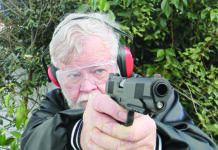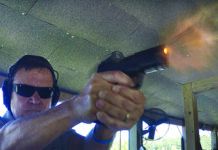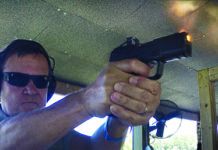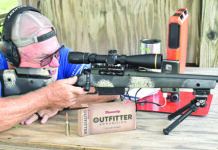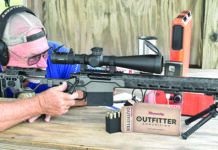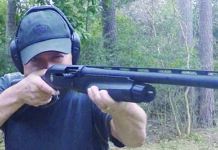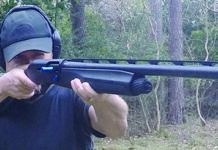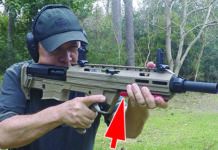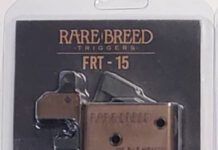We’ve tested ammunition with this caliber of bullet, .308 inch, twice before: Once in .308 Winchester (October 1995 issue) where we tested ammunition with 150-grain bullets, if we could get them, and once in .300 Winchester Magnum (October 1996 issue) using loads with 180-grain or heavier bullets. This time we’re testing ammunition with 165-grain bullets. We think they’re the best choice for the .30-06 Springfield. If we couldn’t find 165-grain bullets, we chose 180-grain bullets.
To get this article ready for October publication, we did the testing in August. As you can imagine, the sporting goods stores didn’t have a very good selection of ammunition on the shelves at that time. So, this year, we bought all our ammunition from Cheap Shot (1-800-334-7468). It’s a mail order discount ammunition store. Prices were heavily discounted and service was fast. All fourteen loads were available there, although three of them weren’t listed in their catalog. One load that we wanted to test was listed, Federal’s Woodliegh Welcore, but it wasn’t available there or anywhere else. Other than that, we tested every different .30-06 load we could find.
An explanation of how we tested and rated the ammunition in this test follows the results of the test.
The Results
The following is a list of the ammunition tested in descending order of performance. There is little difference between the loads within each rating (i.e. Excellent, Good or Mediocre). The summary table [PDFCAP(1)] has more specific information about each load.
Remington 180-grain Safari Grade. This load used a Swift A-Frame bullet. This was the best load of the fourteen .30-06 rounds that we tested. The bullet expanded well in all three mediums and retained most of its weight in all cases. It also delivered the most energy in its class, a result of its speed and weight. As befits a premium load, the case was nickel plated.
A constant problem with jacketed hunting bullets is separation; the jacket comes off the lead core. There are three current and effective solutions to the problem. Swift’s A-Frame uses two of them and that bullet construction accounts for this superior performance. It uses a partitioned jacket with the rear part of the core locked in place behind the partition, but it goes one step further. The front section of the lead core is bonded to the jacket with a process similar to soldering. A flux removes a thin coat of copper oxide from the inside of the jacket, allowing molten lead to bond to the copper alloy jacket. On impact, the jacket opens and folds backwards with the front lead core adhering to it, producing a perfectly mushroomed front end. The partition limits expansion to the front core and holds the bullet together. Note the bulge under the mushroom (see photo). It’s caused by the rear core sliding forward on impact. It’s not bonded in place like the front core. Impacting on a chunk of beef bone produced almost identical results. Only a little more of the lead mushroom wiped off, slightly reducing the retained weight. Our rating: Excellent, the best of test.
Federal Premium 165-grain Trophy Bonded. This load used a Trophy Bonded Bear Claw bullet. This should be your first choice if you prefer a 165-grain bullet with a little less recoil. Here the entire lead core was bonded to the jacket to prevent separation, and bullet performance showed it worked. Both bone and water test mediums produced an excellent mushroom, and it had the largest expansion from bacon in the excellent class. A little less weight was retained in the bone test, but it’s a minor point.
The cases were nickel plated. That didn’t improve the efficiency any, but it looked like a premium load. Nickel plating was applied to prevent the brass cases from corroding from contact with leather, something to consider if you carry your spare ammunition in a leather pouch. Otherwise, it’s just a fancy wrapping. Our rating: Excellent.
Winchester 180-grain Parti-tion Gold. This load used a Nosler Partition Gold bullet. This bullet put Winchester in the excellent class. It was not a bonded bullet and it didn’t need to be. The front core was usually lost on impact, but some separation could be tolerated. Both retained weight and frontal area increase were excellent without that small front core. A steel liner reinforced the rear cavity. This allowed the partition to be placed well forward, retaining most of the lead core (weight) in the rear half. On impact, the front core bulged the jacket into a mushroom shape before it slid off, thus the leading surface of the bullet was a mushroomed jacket. An extra-thick front jacket prevented this mushroom from breaking off or bending back during penetration; the extra long rear section probably held it head-on. This new design from Nosler, where it’s available to the handloader, produced an excellent bullet. In our bone impact test, it out-performed the Swift A-Frame bullet. Our rating: Excellent.
Federal High Energy 180-grain Partition. This load used a Nosler Partition bullet. Only a few years ago, this old favorite bullet was the finest bullet available. At this velocity, it was still a pretty good bullet, but it didn’t do so well at belted magnum speeds. While the rear core stayed locked in place behind the partition, the front core should mushroom. It did just that in our water impact test with good retained weight (71 percent), but in the bone impact test the front core fell off with a resulting loss of retained weight (62 percent). Nonetheless, we felt it was a good .30-06 load and rated it that way. Our rating: Good.
Winchester Super-X 165-grain Pointed Soft Point. No particular effort was made to keep the core in this jacket. Nevertheless, it stayed in place in the water impact test with good results, both in retained weight and frontal area increase. In the bone impact test, the core separated, but not until the very last. We found the core right beside the jacket on the bottom of our catcher tank. Since they penetrated the bone and the entire water column together, we think this was an efficient load.
The discounted price of this ammunition is only around $15 a box, which is about half the price of the better ammunition. If you’re on a tight budget, this is a good load for you. Our rating: Good, the best buy.
Speer Nitrex 165-grain Grand Slam. This bullet was a variation of a partition bullet; the difference was the partition had a hole in it and the rear end was closed. The jacket was filled with molten lead from the top and it ran down through the hole to form the rear core. Like the other partition bullets, the rear core stayed in place very well. The fault with it was the top half of the jacket opened up too much and the top half of the core broke off at the partition. Unlike the Nosler, this jacket didn’t form a good mushroom in the bone medium nor was very much weight retained. Nickel plating the case didn’t help. Our rating: Mediocre.
Winchester Supreme 165-grain Fail Safe. Here a third method was used to prevent separation— the bullet didn’t have a front core. The body of the bullet was copper alloy with a lead core inserted at the rear end. The point was hollow with four grooves on the inside. On impact, the tip opened up and four petals folded outward to form the leading edge. The problem was they promptly broke off, even in bacon at 250-yard velocities. This left just a small square frontal area. Not enough, in our opinion, but it will penetrate. It went all the way through of our catcher tank and hit the far end. The nickel plating on the case didn’t improve our opinion of the round. Our rating: Mediocre.
Federal Classic 165-grain Pro Hunter. This load used a Sierra Pro Hunter bullet. No effort was made to hold the core in and it popped out. While both bullets separated, they did mushroom and both parts came to rest fairly close together. Our rating: Mediocre.
Hornady Custom 165-grain Boat-tail Spire Point Interlock. Hornady made an effort to hold the core in the jacket, but it was a futile effort. The heel of the jacket had an annular groove on the inside, and the lead core formed a ridge in this groove. It didn’t work. On impact, the jacket opened up to a larger diameter than the ridge. The cores popped out, even in our bacon impact test. Note how little that core was distorted (see photo). It didn’t take much to release it.
Both the water and bone impacted bullets separated in such a way as to make it impossible to measure the frontal area, but the retained weight was fair. Our rating: Mediocre.
Hornady Light Magnum 165-grain BTSP Interlock. Both Hornady loads used the same bullet, but this load was a lot faster. It really was a magnum at 2,951 feet per second, but that was too fast for this bullet. It was marginal in the water impact test, but disintegrated in the bone test. Even the bacon impact test at the 250-yard velocity was too severe. Note that this bullet did a little better in the previous slower load. Our rating: Mediocre.
Remington High Velocity 165-grain Core-Lokt. Remington attempted to use the same method as Hornady to hold the core in the jacket. It didn’t work here either, but for a different reason. Not that the jacket opened up enough to release core, but that the core pulled out of the jacket by shearing the ridge off. Both our water and bone impacted bullets disintegrat-ed, but we were able to measure a large frontal area on the bone bullet. Our rating: Mediocre.
Winchester Supreme 165-grain Ballistic Silvertip. Winchester didn’t use any special method to hold this bullet in the jacket. But, one of them stayed in anyway, at least a little of it did in the bone impact test. About a third of the core stayed in about that much jacket. Not a very impressive missile. The other bullet, tested in water, disintegrated. This was the worst nickel-plated load of the test. Our rating: Mediocre, at best.
Federal Premium 165-grain Ballistic Tip. This load used a Nosler Ballistic Tip bullet. This bullet totally disintegrated in a quart of water, just like a good varmint bullet should. But, it shouldn’t be used on big game. It will probably only make a surface wound and result in a lingering death. Our rating: Unsatisfactory for large game.
Remington Premier 165-grain Ballistic Tip. This load also used a Nosler Ballistic Tip bullet. It was the same bullet as in the preceding load, just a little faster. It had the same result, just a little more so. Our rating: Unsatisfactory for big game.
Bottom Line
We highly recommend any of the three loads rated as excellent. There’s no practical difference. Considering how little a cartridge costs compared to the cost of a hunting trip, why settle for less than the best?
Do you have a problem remembering which ammunition is highly rated when you go to the store? Are you buying ammunition for a caliber we haven’t rated? Our chief tester has just one word of advice for you—bonded. Every rifle load with a bonded bullet we have ever tested rated excellent.
How We Tested
All of the bullets in the ammunition tested will expand under the best of conditions, if they hit solid meat or bone at close range. But, at the end of their practical range, that may not be the case, especially if it gets into the lungs without hitting a bone. To test this worst case condition, we pulled the bullet, dumped the powder, and reloaded to about the 250-yard velocity, or about 500 feet per second slower. Awhile back we tried to shoot this reduced load through the salvaged rib cage of a deer, but found it was almost impossible to hit between the ribs from the hair side. Instead, we now shoot into a half-inch thick chunk of bacon with the rind still on. If a bullet will expand from this small impact, you can be certain it will expand under any hunting conditions. All of the .30-06 bullets expanded to some extent in this test. We caught the exiting bullets in our nondistorting bullet catcher for inspection.
Our next test was designed to determine if a bullet would cohere on impact. While any wound that will not heal will eventually kill an animal, a quick kill requires a bullet that penetrates deep into the vital organs and transfers its energy there. A bullet that fragments on impact won’t penetrate. We fired our second shot, a full load right from the box, directly into an inch and a half chunk of beef bone and caught it in our trap. If a bullet will cohere in this medium at muzzle velocity, you can expect it to hold together and penetrate even if it hits the front shoulder bone.
Our third test shot was fired directly into a one-quart sandwich bag of water. This is similar to what a bullet encounters if it doesn’t hit a bone. There’s some truth to the saying “you can shoot into a quart of water, but not out of it.” Only a third of the bullets made it out in one piece. It takes a sturdy bullet to survive this test.
It’s a more severe test than a larger quantity of water. All of the bullets we have fired into a 55-gallon drum of water expanded like an advertising photo and settled gently to the bottom. In a 30-gallon grease drum full of water, the bullets fared fairly well, but the drum didn’t. The bullets had enough energy to splash most of the water out fast enough to leave a vacuum. After three shots, atmospheric pressure had crushed the drum like a gigantic pop can.
We differentiated between a separated bullet and a fragmented one. If the lead core just popped out and landed beside the jacket, we called it separated. It’s still a fairly effective load. If it broke into a lot of small fragments, we called it disintegrated.
Accuracy was tested by shooting a three-shot group at 100 yards with each of two rifles. We used a Winchester Model 70 and a rebarreled Mauser. Both guns had 24-inch barrels. Only the smallest of the two groups was reported. If a load didn’t shoot well in one rifle, it did shoot well in the other. You ought to check the load you select in your rifle before hunting season.
Velocity was measured with an Oehler Model 35 chronograph, actually two chronographs set up to check each other. Only two loads stated their velocity on the box and both overstated it.



